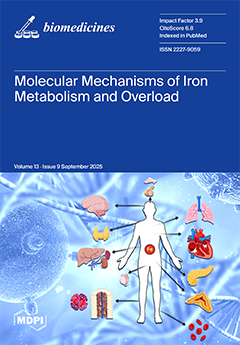Purpose: The venous-to-arterial carbon dioxide partial pressure difference [P(v-a)CO
2] reflects the adequacy of tissue perfusion, with elevated values suggesting impaired clearance of CO
2. While its prognostic role has been investigated in septic shock and high-risk surgery, evidence in postoperative
[...] Read more.
Purpose: The venous-to-arterial carbon dioxide partial pressure difference [P(v-a)CO
2] reflects the adequacy of tissue perfusion, with elevated values suggesting impaired clearance of CO
2. While its prognostic role has been investigated in septic shock and high-risk surgery, evidence in postoperative critically ill patients remains limited. This study aimed to evaluate the prognostic value of ΔP(v-a)CO
2 after major abdominal surgery and its relationship with microcirculatory markers.
Methods: We retrospectively analyzed 86 patients admitted to the intensive care unit (ICU) after major abdominal surgery between September 2020 and October 2023. Arterial and central venous blood gas analyses were performed immediately postoperatively and at 24 h. Patients were stratified into groups according to ΔP(v-a)CO
2 (≤ 0 vs. >0). Postoperative outcomes and correlations with central venous oxygen saturation (ScvO
2) were assessed.
Results: In the subgroup analysis of patients with an initial P(v-a)CO
2 > 6 mmHg, those in the ΔP(v-a)CO
2 > 0 group required mechanical ventilation (54.5% vs. 22.2%,
p = 0.033) and continuous renal replacement therapy (36.4% vs. 8.9%,
p = 0.020) more frequently, with longer durations of both interventions (
p = 0.011 and
p = 0.016, respectively). ICU length of stay and the incidence of acute kidney injury were significantly lower in the ΔP(v-a)CO
2 ≤ 0 group. In addition, a modest negative correlation was observed between ScvO
2 measured at 24 h postoperatively and ΔP(v-a)CO
2.
Conclusions: ΔP(v-a)CO
2 may serve as a useful marker for postoperative risk stratification in critically ill patients undergoing major abdominal surgery. However, given the retrospective design, small sample size, and single-center setting, these findings should be considered hypothesis-generating and require confirmation in larger, prospective multicenter studies.
Full article






